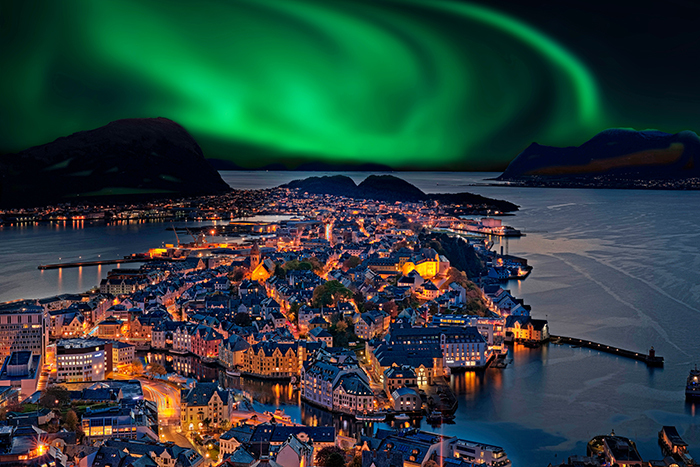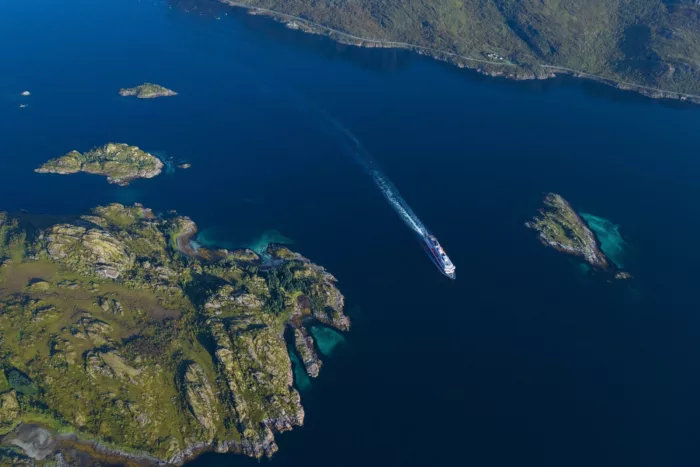
Hurtigruten: The origins of Norway’s shipping hero
Hurtigruten – ‘the fast route’ – has underpinned Norway’s success as the envy of Europe since 1893. Having recently celebrated 130 years of activity, we've been exploring Hurtigruten’s diverse history to uncover the line’s origin story. Fond of an underdog success story? Read on...
Celebrated idiosyncrasies and burlesqued stereotypes often veil a nation’s true heroism. Italy’s gifts to the world – technological innovations, complex regional cultures, automotive passion – remain largely overlooked; courtesy of romantic clichés and platitudes towards spaghetti.
On the other side of the globe, Japan has been typecast through the lens of high-tech gadgets and samurai traditions. Scotland appears to be a nation of whisky-swilling chasers of independence. If you glance at the tabloids, Germany seemingly doesn’t understand humour and France is usually on fire.
And then there’s Norway.
If Netflix is anything to go by, mystery is afoot while visiting this section of Europe. Your demise will subsequently help producers lay the foundations for next season’s Nordic Noir, where endless snow, jagged fjords and reclusive locals – communicating purely in riddles –
help paint a national portrait as Scandinavia’s cold and isolated brethren.
However, that stereotype couldn’t be further from the truth. Norway radiates a shimmering community spirit, blended with a high quality of life and a deep connection to nature. Known for their strong sense of equality and egalitarian values, Norwegians cherish their folklore and act as the blueprint for how other European nations should behave.
Contrary to what Hollywood would have you believe, Norway’s crime rate ranks among the lowest in the world. Stick that in your Lillehammer and smoke it.
Once you delve behind the cultural stereotypes, any visitor to Norway’s kingdom will be welcomed by a wealth of historical adventure and contemporary luxury – and one Norwegian brand epitomises that Scandinavian mantra to perfection.
Sure, Sweden has Volvo. Ok, Finland has Nokia - but Norway has Hurtigruten.

Hurtigruten’s Captain With: The father of modern Norway
Often referred to as the ‘World's Most Beautiful Voyage’, Hurtigruten holds a special place in native hearts. Embodying the unfiltered essence of Norway's cultural and geographical identity, the cruise line was initially established to improve communication along the country’s lengthy and rugged coastline – akin to a Holy mission befalling Indiana Jones or Lara Croft.
That probably sounds easy enough in our modern world, but rewind the clock to Europe’s late 19th century and such a venture emitted untold dangers. Back when our world spun in monochrome, showcasing your ankles was considered obscene and Prime Minister Gregers Gram ran the show , marine transport provided a safety record that would leave adrenaline junkies running for the hills.
Reliable maritime links were all but fantasy before contemporary technology brought assurance to proceedings. That’s where Captain Richard With bucked the trend. During an era where overland travel was arduously slow and desperately unreliable, Captain With set about changing the landscape. Born in Tromso on September 18, 1846, With experienced both the turbulence and effervescent dependence of Norwegian seafaring throughout his youth. It would set the tone for things to come.

As a hearty and visionary sea dog, it didn’t take long for Captain With to understand the fundamental changes required for connecting remote communities. He had witnessed, first-hand, how unconfident reliance on erratic nautical timetables placed a stranglehold on local trade. However – there was a reason why shipping hadn’t caught on in this part of the world.
The 1,250 nautical miles from Bergen to Kirkenes generated a route strewn with narrow inlets, hull-breaching reefs and small islands. Only two sketchy nautical maps of the area existed, and only 28 lighthouses north of Trondheim kept ships from a timeless fate beneath the waves.
It was time for change. While other countries flourished with a maritime network, epitomised by Great Britain’s Transatlantic routes, Norway boasted of nothing permanent. Simply sending a letter from Trondheim to Hammerfest took up to five months. That’s a long time between family updates.
Infrequent steamers and anxiety-stricken antique jekts guaranteed that cargos of fish – herring, halibut and cod – couldn’t reach southern Norway, let alone the European nation’s begging for fresh Norwegian produce.

With’s approach to shipping could ensure a sense of social cohesion and also foster much-needed economic growth, effectively laying the foundations for current-day Norway. The concept had been previously touted, yet few had the bravery and knowledge to undertake such a venture. Fewer still had the command of managing business, tides and trade simultaneously.
When the Norwegian government looked to remedy the situation during 1891, not a single response arrived from national shipping companies invited to submit tenders. Snow-capped tumbleweeds formed and icy crickets chirped when a state-sanctioned route was proposed to support trade and isolated port towns.
Authorities tried again the following year, only for Norway’s two main shipping companies to display complete disinterest. The juggernauts of the era shied away, veiling their terror with aloof detachment, but one man took the challenge.

1893: Birth of Hurtigruten
Norwegian artist Edvard Munch may have produced his celebrated artwork -– ‘The Scream’ – in 1893, but that year’s true masterpiece came from Captain Richard With. Having recognised and studied the challenges of navigating Norway’s lesser-travelled settlements, With founded Hurtigruten using the steamship DS Vesteraalen.
Where the big companies had shied away, Hurtigruten would triumph.
Departing from Trondheim on July 2, 1893, DS Vesteraalen’s maiden voyage called in at nine ports before steaming for Hammerfest; arriving there three days later and 45 minutes ahead of schedule.
Captain With was the son of a shipmaster, having spent his early days working as a navigation officer, and it showed. His tactful and diplomatic approach to navigation resulted in a calm voyage that set a standard for the next 130 years.

With’s previous canny business ventures – having discovered the need for regular shipping after settling, marrying, and opening a trade store in Risoyhamm – had led him into a partnership with Anders Holte.
Holte, an experienced local sailor, worked alongside With to map the Norwegian coastline, before skilled captains were hired to test out With’s navigations in the dark of night. This shaved considerable time off each journey while rivals slept.
Of course, Sceptics ran amok when the announcement was made regarding With’s long-awaited vision of the hurtig ruten (‘the fast route’), yet the public embraced Hurtigruten with open arms.
DS Vesteraalen received a royal welcome upon arrival. Families waved to the ship and showcased homemade flags, slicing through the air with excited bellows as a new age of reliable transport and communication dawned. Letters would now take only a matter of days to reach recipients, and people could now move freely along the coastline. Family and friends were no longer out of reach.
Freedom had arrived. And it bore the name Hurtigruten.

Hurtigruten: Fast. Reliable. Legendary
As the celebrations marking Hurtigruten’s first voyage entered history, captain With continued to command the new maritime service. Norway’s long-overdue maritime revolution conceived a development boom in trade, and other industries reaped the benefits of a fast and reliable steamship schedule.
Before long, Hurtigruten found a natural weekly rhythm and, as popularity climbed steadily into the stratosphere, daily sailings commenced in 1936. The original route quickly expanded south to Bergen and north to Kirkenes on the Russian border, with demand warranting various additions to the shipping fleet. More than 230,000 passengers – locals and tourists alike – now came to depend on the Coastal Express each year. The country was booming.
As Norway’s sprightly exports and trade market pulled the nation into a new century, Hurtigruten provided the ever-dependable underpinnings of success. Captain With retired as a shipmaster and instead took the role as Hurtigruten’s CEO until 1904, later heading off to parliament as an elected MP.
Recognised as the founding father of Hurtigruten, Captain With was knighted First Class of the Royal Norwegian Order of St Olav. Some individuals gain such accolades for services to the theatre or as an avarice-obsessed business tycoon, but Richard With was knighted as “a reward for distinguished services rendered to Norway and mankind”. Beat that, Richard Branson.
Of course, times change, and with the pulsing spread of road networks and air travel, the age-old Hurtigruten service suddenly felt obsolete. Never to be defeated, that’s when Hurtigruten ramped up a gear.

Hurtigruten: Into the modern age
Germany’s occupation of Norway decimated the Hurtigruten fleet. A total of 14 ships, and 700 lives, were claimed between 1940 and 1945. Following the Allied victory and formal acceptance of Germany’s unconditional surrender on May 8, 1945, the redeployment of Hurtigruten coastal express ships became the government’s highest priority.
It took until 1949 for the first in a series of new post-war ships to enter service, with the final replacement ship launched in 1964. These ships would become the backbone of Hurtigruten operations until the 1990s.
The service was catering for over half a million passengers by the turn of 1952, but cultural and societal change lurked upon the horizon. As the neon-lit 1980s took hold, new vessels started to replace the classic ships of old. Road networks and affordable air travel gradually provided other means of cargo and passenger travel, prompting the powers-that-be to invest away from native shipping routes.
Rather than throw in the towel, Hurtigruten adapted their routes to provide further aspects of tourism. The postal service and local transit operations would remain unblemished, even as operating subsidies from the government were gradually phased out.

With an increased emphasis on tourism, Hurtigruten could craft larger and more comfortable ships. From hot tubs to fine dining, the brand moved with the times. This mantra provided an all-new vibe for those seeking a true Norwegian cruise experience, while still operating out of the age-old ports as the native lifeline for local businesses and personal travel. This is where you’ll find Hurtigruten today.
Captain With’s legacy continues to fuel Norway’s progress as the envy of Europe, and while other businesses have become almost sterilised by greed, Hurtigruten continues to operate with dignity, loyalty and local services at heart
Against all the odds, the company operates 365 days a year and in all weather, with a fleet of stunning vessels which mirror the vibe Norwegian stereotypes fight against. It’s not all snow, murder and isolation – as Netflix likes to promote. It’s actually paradise on earth, serviced by – arguably – the most noble cruise line of them all.
Where some businesses and countries view people second to their ticket fee or GDP, Norway and Hurtigruten do things differently. And long may that remain.
It’s not crying. It’s liquid patriotism.

Cruise with Hurtigruten
The Coastal Express - South (Kirkenes - Bergen)
- 5 nights, departs on the 14th Mar 2025
- Cruise info: Hurtigruten, MS Nordkapp
- Itinerary: Kirkenes, Vardø, Båtsfjord +30 more
Norway's Capital to the Arctic Capital - on the North Cape Line (2024-25)
- 6 nights, departs on the 3rd May 2025
- Cruise info: Hurtigruten, MS Trollfjord
- Itinerary: Oslo, Kristiansand, Haugesund +6 more
The Coastal Express - South (Kirkenes - Bergen)
- 5 nights, departs on the 10th Apr 2025
- Cruise info: Hurtigruten, MS Nordnorge
- Itinerary: Kirkenes, Vardø, Båtsfjord +30 more
The Coastal Express - Roundtrip (With transfers)
- 11 nights, departs on the 8th Jun 2025
- Cruise info: Hurtigruten, MS Richard With
- Itinerary: Bergen, Florø, Måløy +65 more







